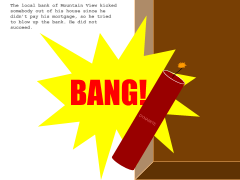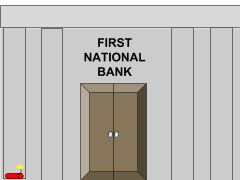Overview
In my past work with schools, I have taken my classes on the following field trips. Following each of our field trips or visits with guest speakers, I ask students to write a reflection to encourage them to contextualize their learning. I also ask students to write a thank you letter addressed to our host, docent, or guest speaker to encourage them to express appreciation.
Baylands
Lucy Evans Nature Center in Palo Alto, CA
 Photo by Trevor Mattea
Photo by Trevor Mattea
As part of this field trip, students attended a docent-led tour and presentation about the baylands, and afterwards the docent oversaw four parent-led stations in which students collected plants, fished, studied microorganisms, and watched birds before describing the physical and behavioral adaptations of area plants and animals.
This field trip was originally designed to accompany the following California Content Standards for Grade 3 Life Sciences:
3.a Students know plants and animals have structures that serve different functions in growth, survival, and reproduction.
3.b Students know examples of diverse life forms in different environments, such as oceans, deserts, tundra, forests, grasslands, and wetlands.
3.c Students know living things cause changes in the environment in which they live: some of these changes are detrimental to the organism or other organisms, and some are beneficial.
3.d Students know when the environment changes, some plants and animals survive and reproduce; others die or move to new locations.
3.e Students know that some kinds of organisms that once lived on Earth have completely disappeared and that some of those resembled others that are alive today.
Additional information about this field trip is available here.
This field trip was originally designed to accompany the following California Content Standards for Grade 3 Life Sciences:
3.a Students know plants and animals have structures that serve different functions in growth, survival, and reproduction.
3.b Students know examples of diverse life forms in different environments, such as oceans, deserts, tundra, forests, grasslands, and wetlands.
3.c Students know living things cause changes in the environment in which they live: some of these changes are detrimental to the organism or other organisms, and some are beneficial.
3.d Students know when the environment changes, some plants and animals survive and reproduce; others die or move to new locations.
3.e Students know that some kinds of organisms that once lived on Earth have completely disappeared and that some of those resembled others that are alive today.
Additional information about this field trip is available here.
The BFG
Don Powell Theatre in San Diego, CA
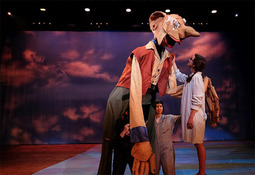 Photo from San Diego State University
Photo from San Diego State University
As part of this field trip, students attended a production of "The BFG" and described similarities and differences between the book and the play.
This field trip was originally designed to accompany the following Common Core State Standards for Grade 4 Reading Literature:
4.2 Determine a theme of a story, drama, or poem from details in the text; summarize the text.
4.3 Describe in depth a character, setting, or event in a story or drama, drawing on specific details in the text (e.g., a character's thoughts, words, or actions).
4.7 Make connections between the text of a story or drama and a visual or oral presentation of the text, identifying where each version reflects specific descriptions and directions in the text.
Additional information about this field trip is available here.
This field trip was originally designed to accompany the following Common Core State Standards for Grade 4 Reading Literature:
4.2 Determine a theme of a story, drama, or poem from details in the text; summarize the text.
4.3 Describe in depth a character, setting, or event in a story or drama, drawing on specific details in the text (e.g., a character's thoughts, words, or actions).
4.7 Make connections between the text of a story or drama and a visual or oral presentation of the text, identifying where each version reflects specific descriptions and directions in the text.
Additional information about this field trip is available here.
The Cay
Louis B. Mayer Theatre in Santa Clara, CA
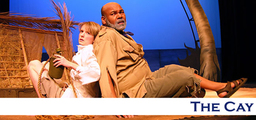 Photo from California Theater Center
Photo from California Theater Center
As part of this field trip, students attended a production of "The Cay" and described the similarities and differences between the book and the play.
This field trip was originally designed to accompany the following California Content Standards for Grade 3 Reading:
3.2 Comprehend basic plots of classic fairy tales, myths, folktales, legends, and fables from around the world.
3.3 Determine what characters are like by what they say or do and by how the author or illustrator portrays them.
3.4 Determine the underlying theme or author’s message in fiction and nonfiction text
3.6 Identify the speaker or narrator in a selection.
Additional information about this field trip is available here.
This field trip was originally designed to accompany the following California Content Standards for Grade 3 Reading:
3.2 Comprehend basic plots of classic fairy tales, myths, folktales, legends, and fables from around the world.
3.3 Determine what characters are like by what they say or do and by how the author or illustrator portrays them.
3.4 Determine the underlying theme or author’s message in fiction and nonfiction text
3.6 Identify the speaker or narrator in a selection.
Additional information about this field trip is available here.
Charlotte's Web
Louis B. Mayer Theatre in Santa Clara, CA
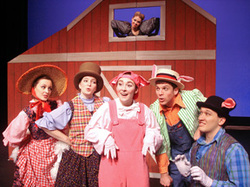 Photo from California Theater Center
Photo from California Theater Center
As part of this field trip, students attended a production of "Charlotte's Web" and described the similarities and differences between the book and the play.
This field trip was originally designed to accompany the following California Content Standards for Grade 3 Reading:
3.2 Comprehend basic plots of classic fairy tales, myths, folktales, legends, and fables from around the world.
3.3 Determine what characters are like by what they say or do and by how the author or illustrator portrays them.
3.4 Determine the underlying theme or author’s message in fiction and nonfiction text
3.6 Identify the speaker or narrator in a selection.
Additional information about this field trip is available here.
This field trip was originally designed to accompany the following California Content Standards for Grade 3 Reading:
3.2 Comprehend basic plots of classic fairy tales, myths, folktales, legends, and fables from around the world.
3.3 Determine what characters are like by what they say or do and by how the author or illustrator portrays them.
3.4 Determine the underlying theme or author’s message in fiction and nonfiction text
3.6 Identify the speaker or narrator in a selection.
Additional information about this field trip is available here.
Discovery Lab
Monterey Bay Aquarium in Monterey, CA
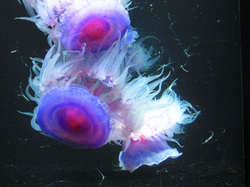 Photo by A.D. (2012-2013)
Photo by A.D. (2012-2013)
As part of this field trip, students participated in a hands-on lab experience led by a docent and described the physical and behavioral adaptations of various sea creatures.
This field trip was originally designed to accompany the following California Content Standards for Grade 3 Life Sciences:
3.a Students know plants and animals have structures that serve different functions in growth, survival, and reproduction.
3.b Students know examples of diverse life forms in different environments, such as oceans, deserts, tundra, forests, grasslands, and wetlands.
3.c Students know living things cause changes in the environment in which they live: some of these changes are detrimental to the organism or other organisms, and some are beneficial.
3.d Students know when the environment changes, some plants and animals survive and reproduce; others die or move to new locations.
3.e Students know that some kinds of organisms that once lived on Earth have completely disappeared and that some of those resembled others that are alive today.
Additional information about this field trip is available here.
This field trip was originally designed to accompany the following California Content Standards for Grade 3 Life Sciences:
3.a Students know plants and animals have structures that serve different functions in growth, survival, and reproduction.
3.b Students know examples of diverse life forms in different environments, such as oceans, deserts, tundra, forests, grasslands, and wetlands.
3.c Students know living things cause changes in the environment in which they live: some of these changes are detrimental to the organism or other organisms, and some are beneficial.
3.d Students know when the environment changes, some plants and animals survive and reproduce; others die or move to new locations.
3.e Students know that some kinds of organisms that once lived on Earth have completely disappeared and that some of those resembled others that are alive today.
Additional information about this field trip is available here.
Discovery Lab
Seymour Marine Discovery Center in Santa Cruz, CA
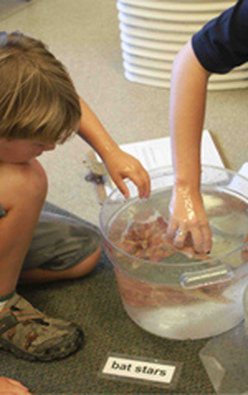 Photo from Seymour Marine Discovery Center
Photo from Seymour Marine Discovery Center
As part of this field trip, students participated in a hands-on lab experience led by a docent.
This field trip was originally designed to accompany the following California Content Standards for Grade 2 Life Sciences:
2.a Students know that organisms reproduce offspring of their own kind and that the offspring resemble their parents and one another.
2.b Students know the sequential stages of life cycles are different for different animals, such as butterflies, frogs, and mice.
2.c Students know many characteristics of an organism are inherited from the parents. Some characteristics are caused or influenced by the environment.
2.d Students know there is variation among individuals of one kind within a population.
2.e Students know light, gravity, touch, or environmental stress can affect the germination, growth, and development of plants.
2.f Students know flowers and fruits are associated with reproduction in plants.
Additional information about this field trip is available here.
This field trip was originally designed to accompany the following California Content Standards for Grade 2 Life Sciences:
2.a Students know that organisms reproduce offspring of their own kind and that the offspring resemble their parents and one another.
2.b Students know the sequential stages of life cycles are different for different animals, such as butterflies, frogs, and mice.
2.c Students know many characteristics of an organism are inherited from the parents. Some characteristics are caused or influenced by the environment.
2.d Students know there is variation among individuals of one kind within a population.
2.e Students know light, gravity, touch, or environmental stress can affect the germination, growth, and development of plants.
2.f Students know flowers and fruits are associated with reproduction in plants.
Additional information about this field trip is available here.
Downtown Historical Tour
Castro Street in Mountain View, CA
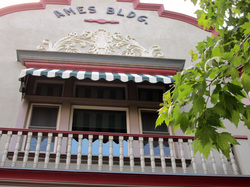 Photo by E.L.B. (2012-2013)
Photo by E.L.B. (2012-2013)
As part of this field trip, students participated in a tour of historical buildings in downtown Mountain View led by parent volunteers acting in character and made timelines documenting major events.
This field trip was originally designed to accompany the following California Content Standards for Grade 3 Continuity and Change:
3.3.1 Research the explorers who visited here, the newcomers who settled here, and the people who continue to come to the region, including their cultural and religious traditions and contributions.
3.3.2 Describe the economies established by settlers and their influence on the present-day economy, with emphasis on the importance of private property and entrepreneurship.
3.3.3 Trace why their community was established, how individuals and families contributed to its founding and development, and how the community has changed over time, drawing on maps, photographs, oral histories, letters, newspapers, and other primary sources.
Additional information about this field trip is available here.
A book outlining the history of Mountain View is available here.
A pamphlet outlining downtown Mountain View's historical buildings is available here.
This field trip was originally designed to accompany the following California Content Standards for Grade 3 Continuity and Change:
3.3.1 Research the explorers who visited here, the newcomers who settled here, and the people who continue to come to the region, including their cultural and religious traditions and contributions.
3.3.2 Describe the economies established by settlers and their influence on the present-day economy, with emphasis on the importance of private property and entrepreneurship.
3.3.3 Trace why their community was established, how individuals and families contributed to its founding and development, and how the community has changed over time, drawing on maps, photographs, oral histories, letters, newspapers, and other primary sources.
Additional information about this field trip is available here.
A book outlining the history of Mountain View is available here.
A pamphlet outlining downtown Mountain View's historical buildings is available here.
Downtown Restaurant Tour
Castro Street in Mountain View, CA
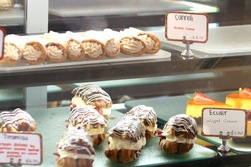 Photo by Trish Peach
Photo by Trish Peach
- As part of this field trip, students selected restaurants in downtown Mountain View to visit for lunch before writing reviews about the food, service, and ambiance.
This field trip was originally designed to accompany the following California Content Standards for Grade 3 Number Sense:
2.1 Find the sum or difference of two whole numbers between 0 and 10,000.
2.7 Determine the unit cost when given the total cost and number of units.
Additional information about this field trip is available here.
Earth, Sun & Moon
Fujitsu Planetarium in Cupertino, CA
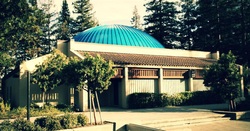 Photo from De Anza College
Photo from De Anza College
As part of this field trip, students attended a production of "Earth, Sun, & Moon" and a docent-led discussion about the solar system before describing misconceptions about the three celestial bodies before writing a constellation story.
This field trip was originally designed to accompany the following California Content Standards for Grade 3 Earth Sciences:
4.a Students know the patterns of stars stay the same, although they appear to move across the sky nightly, and different stars can be seen in different seasons.
4.b Students know the way in which the Moon’s appearance changes during the four-week lunar cycle.
4.c Students know telescopes magnify the appearance of some distant objects in the sky, including the Moon and the planets. The number of stars that can be seen through telescopes is dramatically greater than the number that can be seen by the unaided eye.
4.d Students know that Earth is one of several planets that orbit the Sun and that the Moon orbits Earth.
4.e Students know the position of the Sun in the sky changes during the course of the day and from season to season.
Additional information about this field trip is available here.
This field trip was originally designed to accompany the following California Content Standards for Grade 3 Earth Sciences:
4.a Students know the patterns of stars stay the same, although they appear to move across the sky nightly, and different stars can be seen in different seasons.
4.b Students know the way in which the Moon’s appearance changes during the four-week lunar cycle.
4.c Students know telescopes magnify the appearance of some distant objects in the sky, including the Moon and the planets. The number of stars that can be seen through telescopes is dramatically greater than the number that can be seen by the unaided eye.
4.d Students know that Earth is one of several planets that orbit the Sun and that the Moon orbits Earth.
4.e Students know the position of the Sun in the sky changes during the course of the day and from season to season.
Additional information about this field trip is available here.
Elephant Seals
Año Nuevo State Reserve in Pescadero, CA
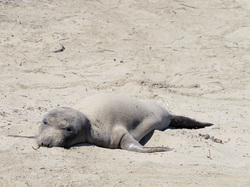 Photo by Trevor Mattea
Photo by Trevor Mattea
As part of this field trip, students participated in a docent-led tour of the beaches at Año Nuevo State Reserve and described the physical and behavioral adaptations of elephant seals.
This field trip was originally designed to accompany the following California Content Standards for Grade 3 Life Sciences:
3.a Students know plants and animals have structures that serve different functions in growth, survival, and reproduction.
3.b Students know examples of diverse life forms in different environments, such as oceans, deserts, tundra, forests, grasslands, and wetlands.
3.c Students know living things cause changes in the environment in which they live: some of these changes are detrimental to the organism or other organisms, and some are beneficial.
3.d Students know when the environment changes, some plants and animals survive and reproduce; others die or move to new locations.
3.e Students know that some kinds of organisms that once lived on Earth have completely disappeared and that some of those resembled others that are alive today.
Additional information about this field trip is available here.
This field trip was originally designed to accompany the following California Content Standards for Grade 3 Life Sciences:
3.a Students know plants and animals have structures that serve different functions in growth, survival, and reproduction.
3.b Students know examples of diverse life forms in different environments, such as oceans, deserts, tundra, forests, grasslands, and wetlands.
3.c Students know living things cause changes in the environment in which they live: some of these changes are detrimental to the organism or other organisms, and some are beneficial.
3.d Students know when the environment changes, some plants and animals survive and reproduce; others die or move to new locations.
3.e Students know that some kinds of organisms that once lived on Earth have completely disappeared and that some of those resembled others that are alive today.
Additional information about this field trip is available here.
The Environment at Deer Hollow Farm
Deer Hollow Farm in Mountain View, CA
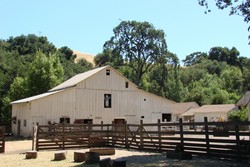 Photo from Deer Hollow Farm
Photo from Deer Hollow Farm
As part of this field trip, students participated in a docent-led tour of a farm.
This field trip was originally designed to accompany the following California Content Standards for Grade 2 Life Sciences:
2.a Students know that organisms reproduce offspring of their own kind and that the offspring resemble their parents and one another.
2.c Students know many characteristics of an organism are inherited from the parents. Some characteristics are caused or influenced by the environment.
Additional information about this field trip is available here.
This field trip was originally designed to accompany the following California Content Standards for Grade 2 Life Sciences:
2.a Students know that organisms reproduce offspring of their own kind and that the offspring resemble their parents and one another.
2.c Students know many characteristics of an organism are inherited from the parents. Some characteristics are caused or influenced by the environment.
Additional information about this field trip is available here.
Giants Geometry: The Shape of the Game
AT&T Park in San Francisco, CA
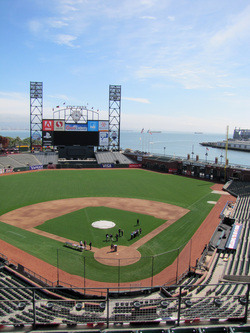 Photo by Trevor Mattea
Photo by Trevor Mattea
As part of this field trip, students attended a presentation about the history and geometry of baseball before attending in a docent-led, behind-the-scenes tour of AT&T Park and solving problems related to area and perimeter.
This field trip was originally designed to accompany the following California Content Standards for Grade 3 Measurement and Geometry:
2.1 Identify, describe, and classify polygons (including pentagons, hexagons, and octagons).
2.2 Identify attributes of triangles (e.g., two equal sides for the isosceles triangle, three equal sides for the equilateral triangle, right angle for the right triangle).
2.3 Identify attributes of quadrilaterals (e.g., parallel sides for the parallelogram, right angles for the rectangle, equal sides and right angles for the square).
2.4 Identify right angles in geometric figures or in appropriate objects and determine whether other angles are greater or less than a right angle.
2.5 Identify, describe, and classify common three-dimensional geometric objects (e.g., cube, rectangular solid, sphere, prism, pyramid, cone, cylinder).
2.6 Identify common solid objects that are the components needed to make a more complex solid object.
Additional information about this field trip is available here.
This field trip was originally designed to accompany the following California Content Standards for Grade 3 Measurement and Geometry:
2.1 Identify, describe, and classify polygons (including pentagons, hexagons, and octagons).
2.2 Identify attributes of triangles (e.g., two equal sides for the isosceles triangle, three equal sides for the equilateral triangle, right angle for the right triangle).
2.3 Identify attributes of quadrilaterals (e.g., parallel sides for the parallelogram, right angles for the rectangle, equal sides and right angles for the square).
2.4 Identify right angles in geometric figures or in appropriate objects and determine whether other angles are greater or less than a right angle.
2.5 Identify, describe, and classify common three-dimensional geometric objects (e.g., cube, rectangular solid, sphere, prism, pyramid, cone, cylinder).
2.6 Identify common solid objects that are the components needed to make a more complex solid object.
Additional information about this field trip is available here.
Hands-On History
Campbell Historical Museum and Ainsley House Foundation in Campbell, CA
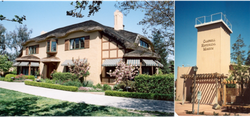 Photo from Campbell Historical Museum
Photo from Campbell Historical Museum
- As part of this field trip, students attended a docent-led presentation and tour about the history of the nearby community of Campbell before describing the experience in an informative paragraph.
This field trip was originally designed to accompany the following California Content Standards for Grade 2 Continuity and Change:
2.2.2 Compare and contrast their daily lives with those of their parents, grandparents, and/or guardians.
Additional information about this field trip is available here.
Natural Bridges
Natural Bridges State Beach in Santa Cruz, CA
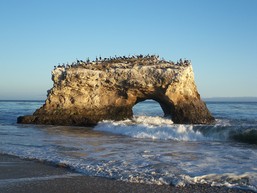 Photo from Wikipedia
Photo from Wikipedia
As part of this field trip, students participated in a docent-led tour of a natural bridges.
This field trip was originally designed to accompany the following California Content Standards for Grade 2 Life Sciences:
2.a Students know that organisms reproduce offspring of their own kind and that the offspring resemble their parents and one another.
2.b Students know the sequential stages of life cycles are different for different animals, such as butterflies, frogs, and mice.
2.c Students know many characteristics of an organism are inherited from the parents. Some characteristics are caused or influenced by the environment.
2.d Students know there is variation among individuals of one kind within a population.
2.e Students know light, gravity, touch, or environmental stress can affect the germination, growth, and development of plants.
2.f Students know flowers and fruits are associated with reproduction in plants.
Additional information about this field trip is available here.
This field trip was originally designed to accompany the following California Content Standards for Grade 2 Life Sciences:
2.a Students know that organisms reproduce offspring of their own kind and that the offspring resemble their parents and one another.
2.b Students know the sequential stages of life cycles are different for different animals, such as butterflies, frogs, and mice.
2.c Students know many characteristics of an organism are inherited from the parents. Some characteristics are caused or influenced by the environment.
2.d Students know there is variation among individuals of one kind within a population.
2.e Students know light, gravity, touch, or environmental stress can affect the germination, growth, and development of plants.
2.f Students know flowers and fruits are associated with reproduction in plants.
Additional information about this field trip is available here.
Ohlone Day
Stevenson PACT Elementary School in Mountain View, CA
 Photo by Trevor Mattea
Photo by Trevor Mattea
As part of this field trip, a docent came to our school to talk to students about Ohlone daily routines and games, describe how the Ohlone adapted to their natural environment, and oversee five parent-led stations in which students participated in simulations focused on body art, food preparation, games, hunting and gathering, and tools.
This field trip was originally designed to accompany the following California Content Standards for Grade 3 Continuity and Change:
3.2.1 Describe national identities, religious beliefs, customs, and various folklore traditions.
3.2.2 Discuss the ways in which physical geography, including climate, influenced how the local Indian nations adapted to their natural environment (e.g., how they obtained food, clothing, tools).
3.2.3 Describe the economy and systems of government, particularly those with tribal constitutions, and their relationship to federal and state governments.
3.2.4 Discuss the interaction of new settlers with the already established Indians of the region.
Additional information about this field trip is available here.
A book outlining the history of Ohlone is available here.
This field trip was originally designed to accompany the following California Content Standards for Grade 3 Continuity and Change:
3.2.1 Describe national identities, religious beliefs, customs, and various folklore traditions.
3.2.2 Discuss the ways in which physical geography, including climate, influenced how the local Indian nations adapted to their natural environment (e.g., how they obtained food, clothing, tools).
3.2.3 Describe the economy and systems of government, particularly those with tribal constitutions, and their relationship to federal and state governments.
3.2.4 Discuss the interaction of new settlers with the already established Indians of the region.
Additional information about this field trip is available here.
A book outlining the history of Ohlone is available here.
The Ohlone at Coyote Hills
Coyote Hills Regional Park in Fremont, CA
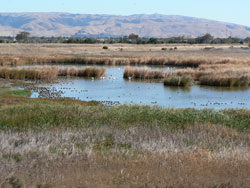 Photo from Coyote Hills Regional Park
Photo from Coyote Hills Regional Park
As part of this field trip, students attended a docent-led discussion about Ohlone life before reenacting daily routines and games and describing how the Ohlone adapted to their natural environment.
This field trip was originally designed to accompany the following California Content Standards for Grade 3 Continuity and Change:
3.2.3 Describe the economy and systems of government, particularly those with tribal constitutions, and their relationship to federal and state governments.
3.2.4 Discuss the interaction of new settlers with the already established Indians of the region.
Additional information about this field trip is available here.
A book outlining the history of Ohlone is available here.
This field trip was originally designed to accompany the following California Content Standards for Grade 3 Continuity and Change:
- 3.2.1 Describe national identities, religious beliefs, customs, and various folklore traditions.
3.2.3 Describe the economy and systems of government, particularly those with tribal constitutions, and their relationship to federal and state governments.
3.2.4 Discuss the interaction of new settlers with the already established Indians of the region.
Additional information about this field trip is available here.
A book outlining the history of Ohlone is available here.
The Ohlone at Deer Hollow Farm
Deer Hollow Farm in Mountain View, CA
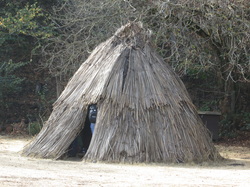 Photo by Trevor Mattea
Photo by Trevor Mattea
As part of this field trip, students participated in a docent-led tour of an Ohlone settlement before reenacting daily routines and games and describing how the Ohlone adapted to their natural environment.
This field trip was originally designed to accompany the following California Content Standards for Grade 3 Continuity and Change:
3.2.1 Describe national identities, religious beliefs, customs, and various folklore traditions.
3.2.2 Discuss the ways in which physical geography, including climate, influenced how the local Indian nations adapted to their natural environment (e.g., how they obtained food, clothing, tools).
3.2.3 Describe the economy and systems of government, particularly those with tribal constitutions, and their relationship to federal and state governments.
3.2.4 Discuss the interaction of new settlers with the already established Indians of the region.
Additional information about this field trip is available here.
A book outlining the history of Ohlone is available here.
This field trip was originally designed to accompany the following California Content Standards for Grade 3 Continuity and Change:
3.2.1 Describe national identities, religious beliefs, customs, and various folklore traditions.
3.2.2 Discuss the ways in which physical geography, including climate, influenced how the local Indian nations adapted to their natural environment (e.g., how they obtained food, clothing, tools).
3.2.3 Describe the economy and systems of government, particularly those with tribal constitutions, and their relationship to federal and state governments.
3.2.4 Discuss the interaction of new settlers with the already established Indians of the region.
Additional information about this field trip is available here.
A book outlining the history of Ohlone is available here.
Physics of Roller Coasters
The Tech Museum of Innovation in Mountain View, CA
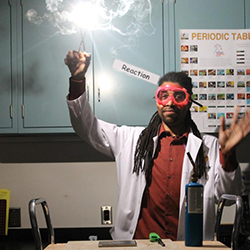 Photo from the Tech Museum
Photo from the Tech Museum
As part of this field trip, students participated in a hands-on lab experience led by a docent and described the physics of roller coasters.
This field trip was originally designed to accompany the following California Content Standards for Grade 2 Physical Sciences and Investigation and Experimentation:
1.a Students know the position of an object can be described by locating it in relation to another object or to the background.
1.c Students know the way to change how something is moving is by giving it a push or a pull. The size of the change is related to the strength, or the amount of force, of the push or pull.
1.d Students know tools and machines are used to apply pushes and pulls (forces) to make things move.
1.e Students know objects fall to the ground unless something holds them up.
4.a Make predictions based on observed patterns and not random guessing.
4.b Measure length, weight, temperature, and liquid volume with appropriate tools and express those measurements in standard metric system units.
4.c Compare and sort common objects according to two or more physical attributes (e.g., color, shape, texture, size, weight).
4.d Write or draw descriptions of a sequence of steps, events, and observations.
4.e Construct bar graphs to record data, using appropriately labeled axes.
4.f Use magnifiers or microscopes to observe and draw descriptions of small objects or small features of objects. 4.g Follow oral instructions for a scientific investigation.
Additional information about this field trip is available here.
This field trip was originally designed to accompany the following California Content Standards for Grade 2 Physical Sciences and Investigation and Experimentation:
1.a Students know the position of an object can be described by locating it in relation to another object or to the background.
1.c Students know the way to change how something is moving is by giving it a push or a pull. The size of the change is related to the strength, or the amount of force, of the push or pull.
1.d Students know tools and machines are used to apply pushes and pulls (forces) to make things move.
1.e Students know objects fall to the ground unless something holds them up.
4.a Make predictions based on observed patterns and not random guessing.
4.b Measure length, weight, temperature, and liquid volume with appropriate tools and express those measurements in standard metric system units.
4.c Compare and sort common objects according to two or more physical attributes (e.g., color, shape, texture, size, weight).
4.d Write or draw descriptions of a sequence of steps, events, and observations.
4.e Construct bar graphs to record data, using appropriately labeled axes.
4.f Use magnifiers or microscopes to observe and draw descriptions of small objects or small features of objects. 4.g Follow oral instructions for a scientific investigation.
Additional information about this field trip is available here.
The Planets
Fujitsu Planetarium in Cupertino, CA
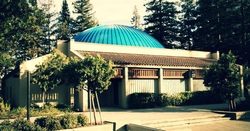 Photo from De Anza College
Photo from De Anza College
As part of this field trip, students attended a production of "The Planets" and a docent-led discussion about the solar system before describing features of planets and dwarf planets before writing a constellation story.
This field trip was originally designed to accompany the following California Content Standards for Grade 3 Earth Sciences:
4.a Students know the patterns of stars stay the same, although they appear to move across the sky nightly, and different stars can be seen in different seasons.
4.b Students know the way in which the Moon’s appearance changes during the four-week lunar cycle.
4.c Students know telescopes magnify the appearance of some distant objects in the sky, including the Moon and the planets. The number of stars that can be seen through telescopes is dramatically greater than the number that can be seen by the unaided eye.
4.d Students know that Earth is one of several planets that orbit the Sun and that the Moon orbits Earth.
4.e Students know the position of the Sun in the sky changes during the course of the day and from season to season.
Additional information about this field trip is available here.
This field trip was originally designed to accompany the following California Content Standards for Grade 3 Earth Sciences:
4.a Students know the patterns of stars stay the same, although they appear to move across the sky nightly, and different stars can be seen in different seasons.
4.b Students know the way in which the Moon’s appearance changes during the four-week lunar cycle.
4.c Students know telescopes magnify the appearance of some distant objects in the sky, including the Moon and the planets. The number of stars that can be seen through telescopes is dramatically greater than the number that can be seen by the unaided eye.
4.d Students know that Earth is one of several planets that orbit the Sun and that the Moon orbits Earth.
4.e Students know the position of the Sun in the sky changes during the course of the day and from season to season.
Additional information about this field trip is available here.
Point Montara
Point Montara Lighthouse Hostel in Montara, CA
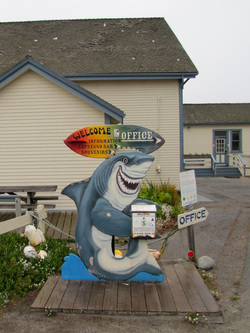 Photo by Trevor Mattea
Photo by Trevor Mattea
- As part of this field trip, students spent the night at the hostel in order to spend time exploring the surrounding area and writing descriptions of the lighthouse and beaches.
- This field trip was originally designed to accompany the following California Content Standards for Grade 3 Writing:
2.2 Write descriptions that use concrete sensory details to present and support unified impressions of people, places, things, or experiences.
A book outlining the history of Point Montara Lighthouse is available here.
Project Look!
Palo Alto Art Center in Palo Alto, CA
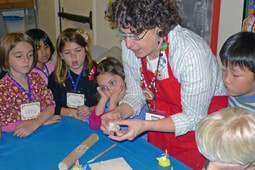 Photo from Palo Alto Art Center
Photo from Palo Alto Art Center
As part of this field trip, students participated in a portraiture workshop, in which they created self-portraits.
2.2 Mix and apply tempera paints to create tints, shades, and neutral colors.
2.4 Create a work of art based on the observation of objects and scenes in daily life, emphasizing value changes.
4.2 Identify successful and less successful compositional and expressive qualities of their own works of art and describe what might be done to improve them.
Additional information about this field trip is available here.
- This field trip was originally designed to accompany the following California Content Standards for Grade 3 Visual and Performing Arts:
2.2 Mix and apply tempera paints to create tints, shades, and neutral colors.
2.4 Create a work of art based on the observation of objects and scenes in daily life, emphasizing value changes.
4.2 Identify successful and less successful compositional and expressive qualities of their own works of art and describe what might be done to improve them.
Additional information about this field trip is available here.
Rengstorff House
Rengstorff House in Mountain View, CA
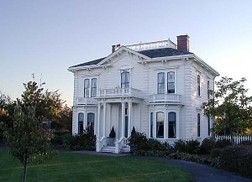 Photo from Rengstorff House
Photo from Rengstorff House
As part of this field trip, students attended in a docent-led presentation and tour of a historical building and property in Mountain View before describing the experience in an informative paragraph.
This field trip was originally designed to accompany the following California Content Standards for Grade 3 Continuity and Change:
3.3.1 Research the explorers who visited here, the newcomers who settled here, and the people who continue to come to the region, including their cultural and religious traditions and contributions.
3.3.2 Describe the economies established by settlers and their influence on the present-day economy, with emphasis on the importance of private property and entrepreneurship.
3.3.3 Trace why their community was established, how individuals and families contributed to its founding and development, and how the community has changed over time, drawing on maps, photographs, oral histories, letters, newspapers, and other primary sources.
Additional information about this field trip is available here.
An activity book about the Rengstorff House is available here.
A book outlining the history of Mountain View is available here.
A pamphlet outlining Mountain View's historic homes is available here.
This field trip was originally designed to accompany the following California Content Standards for Grade 3 Continuity and Change:
3.3.1 Research the explorers who visited here, the newcomers who settled here, and the people who continue to come to the region, including their cultural and religious traditions and contributions.
3.3.2 Describe the economies established by settlers and their influence on the present-day economy, with emphasis on the importance of private property and entrepreneurship.
3.3.3 Trace why their community was established, how individuals and families contributed to its founding and development, and how the community has changed over time, drawing on maps, photographs, oral histories, letters, newspapers, and other primary sources.
Additional information about this field trip is available here.
An activity book about the Rengstorff House is available here.
A book outlining the history of Mountain View is available here.
A pamphlet outlining Mountain View's historic homes is available here.
The Safeway World Championship Pumpkin Weigh-Off
Main Street in Half Moon Bay, CA
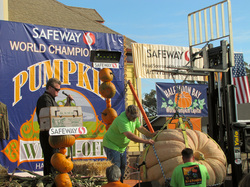 Photo by Trevor Mattea
Photo by Trevor Mattea
As part of this field trip, students attended pumpkin weigh-off and recorded the results before interviewing farmers from the region and solving problems related to rounding.
This field trip was originally designed to accompany the following California Content Standards for Grade 3 Number Sense:
1.1 Count, read, and write whole numbers to 10,000.
1.2 Compare and order whole numbers to 10,000.
1.3 Identify the place value for each digit in numbers to 10,000.
1.4 Round off numbers to 10,000 to the nearest ten, hundred, and thousand.
1.5 Use expanded notation to represent numbers (e.g., 3,206 = 3,000 + 200 + 6).
2.1 Find the sum or difference of two whole numbers between 0 and 10,000.
Additional information about this field trip is available here.
This field trip was originally designed to accompany the following California Content Standards for Grade 3 Number Sense:
1.1 Count, read, and write whole numbers to 10,000.
1.2 Compare and order whole numbers to 10,000.
1.3 Identify the place value for each digit in numbers to 10,000.
1.4 Round off numbers to 10,000 to the nearest ten, hundred, and thousand.
1.5 Use expanded notation to represent numbers (e.g., 3,206 = 3,000 + 200 + 6).
2.1 Find the sum or difference of two whole numbers between 0 and 10,000.
Additional information about this field trip is available here.
Storytelling and Bookmaking
826 Valencia in San Francisco, CA
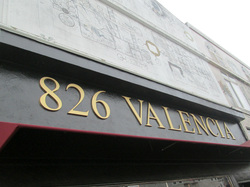 Photo by Platipus 25
Photo by Platipus 25
As part of this field trip, students worked with 826 volunteers to create an original story with characters, plot, and setting before revising and editing it, so that they could take home bound paperback copies of the book.
This field trip was originally designed to accompany the following California Content Standards for Grade 3 Writing:
2.1.a Provide a context within which an action takes place.
2.1.b Include well-chosen details to develop the plot.
2.1.c Provide insight into why the selected incident is memorable.
2.2 Write descriptions that use concrete sensory details to present and support unified impressions of people, places, things, or experiences.
Additional information about this field trip is available here.
This field trip was originally designed to accompany the following California Content Standards for Grade 3 Writing:
2.1.a Provide a context within which an action takes place.
2.1.b Include well-chosen details to develop the plot.
2.1.c Provide insight into why the selected incident is memorable.
2.2 Write descriptions that use concrete sensory details to present and support unified impressions of people, places, things, or experiences.
Additional information about this field trip is available here.
Food Fight! on Planet Bakery
|
During our trip to 826 Valencia, our entire class collaborated to write an original story. After a brief introduction about the project, the whole class first selected a time and place for the story. Next, small groups created character profiles for the protagonist, antagonist, and sidekick before presenting them to the whole class. Then, volunteers took on the roles of the characters in order to write some dialogue to drive the story forward. After that, the whole class brought the story to a cliffhanger. Finally, students had about half an hour to write their own endings to the story. The books were bound and delivered to us, while we were eating lunch at a nearby park.
|
|
Sustainable Community Farms
Full Circle Farm in Sunnyvale, CA
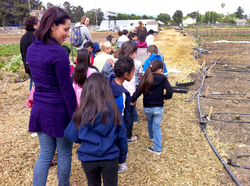 Photo from Full Circle Farm
Photo from Full Circle Farm
As part of this field trip, students participated in a docent-led tour of a farm.
This field trip was originally designed to accompany the following California Content Standards for Grade 2 People Who Make a Difference:
2.4.3 Understand how limits on resources affect production and consumption (what to produce and what to consume).
Additional information about this field trip is available here.
This field trip was originally designed to accompany the following California Content Standards for Grade 2 People Who Make a Difference:
- 2.4.1 Describe food production and consumption long ago and today, including the roles of farmers, processors, distributors, weather, and land and water resources.
2.4.3 Understand how limits on resources affect production and consumption (what to produce and what to consume).
Additional information about this field trip is available here.
Westminster Woods
Westminster Woods in Occidental, CA
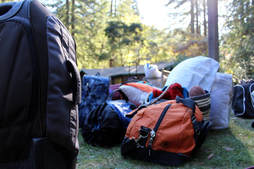 Photo by Trevor Mattea
Photo by Trevor Mattea
As part of this field trip, students spent the night at the retreat center in order to spend time exploring the surrounding area's ecology and team building.
Additional information about this field trip is available here.
Additional information about this field trip is available here.
School Board Meetings
|
Following our project, some students decided to accompany me to school board meetings, which were held twice a month and open to the public. During the meetings, trustees and district employees discuss issues, such as budgets, facilities, and curriculum. So that students can access more material and fully participate in the meetings, I sat with them and took notes on the proceedings in order to define new words, provide helpful analogies, and answer their questions.
|
|
Virtual Field Trips
Through a partnership with Google Connected Classrooms, I took my class on virtual field trips to the Seattle Aquarium, the Minnesota Zoo, and Solar Impulse via Google Hangouts on Air. We were one of the first classrooms to participate in this exciting new program! Following each of our virtual field trips, I ask students to write a reflection in a Google Doc in order to encourage them to put their learning into context.
We have also Skyped with multiple classrooms. During spring 2013, we Skyped with Mr. Mahdavian's fifth-grade class in Richmond, CA, and students from Kampala, Uganda, in order to share our learning. During spring 2013, we had a Mystery Skype with Mrs. Schantz's third-grade class in Clinton, OK. Her class documented the exchange here. During fall 2012, we Skyped with both Ms. Vierling's P.E. and movement class in Burlington, VT, and Ms. Williams's third-grade class in Surrey, BC, in order to share our learning. The later of whom documented the exchange on her blog.
Field Trip Notecatchers
During each of our field trips, guest speaker presentations, or special lessons, I ask students to take notes to help them discuss and reflect upon the experience with their classmates.
- Wells Fargo Presentation Notecatcher
- Balloon Car Presentation Notecatcher
- Book Fair Notecatcher
Field Trip Drawing Exemplars
Following each of our field trips, guest speakers, or special lessons, I ask students to create a visual reflection as a Google Drawing in addition to their written reflections to further encourage them to contextualize their learning.
